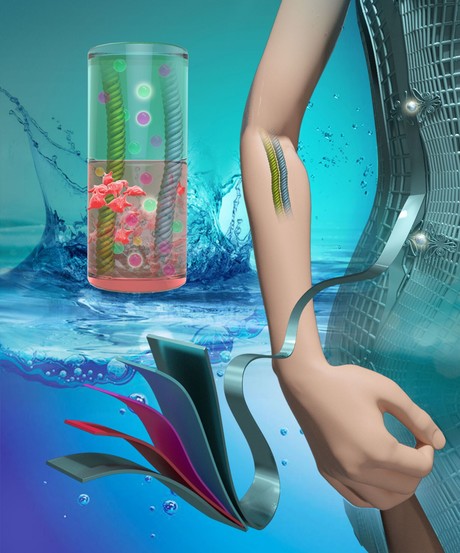Bendable batteries in the human body

Researchers from China’s Fudan University have engineered bendable batteries, suitable for implantation in the human body, which can run on body-inspired liquids such as a normal IV saline solution and a cell-culture medium.
The researchers designed their batteries by focusing on the mechanical-stress demands of wearable electronics and the safety requirements of implantable electronics. The results have been published in the journal Chem.
“Current batteries, like the lithium-ion ones used in medical implants, generally come in rigid shapes,” said Yonggang Wang, co-senior author on the paper. “Additionally, most of the reported flexible batteries are based on flammable organic or corrosive electrolytes, which suffer from safety hazards and poor biocompatibility for wearable devices, let alone implantable ones.”
Safety measures for wearable and implantable batteries have generally involved structural reinforcement to prevent hazardous chemicals from leaking out. Looking to remove this hurdle, Wang and his colleagues swapped out these toxic and flammable liquids for cheap and environmentally conscious sodium-ion solutions.
The researchers came across two biocompatible solutions that were suitable for implantable devices, given that they pose no harm to the surface or interior of the body: a normal saline solution that is pumped into the body in most IV treatments and a cell-culture medium that contains amino acids, sugars and vitamins in addition to sodium ions, and thus mimics the fluid that surrounds human cells. With these solutions in tow, the danger from electrolyte leakage is now minimised.
Freed from leakage concerns, which can require so much protective material that batteries become bulky and unbendable, the researchers designed two types of flexible batteries: a 2D ‘belt’-shaped battery, for which they adhered thin electrode films to a net of steel strands, and a 1D fibre-shaped battery, for which they embedded nanoparticles of electrode material around a carbon nanotube backbone. The researchers also tested ordinary sodium sulfate, a safe and fairly inert solution, as a liquid electrolyte suitable for use in external wearable devices.
With sodium sulfate solution as the electrolyte, both battery types outperformed most of the reported wearable lithium-ion batteries in terms of charge-holding capacity and power output for their size. That performance held up when the authors folded and bent the batteries to mimic the impact of wrapping a sensor, watch or similar device around one’s arm. Charge-holding capacity was only marginally reduced for the saline- and cell-culture-based batteries — likely because they had slightly lower sodium-ion content than the sodium sulfate solution, according to the researchers.
The researchers were also surprised to discover a side effect in their fibre-shaped battery, which means it could be deployed in biomedical applications. The same carbon nanotubes that make up the skeleton of the 1D battery can accelerate the conversion of dissolved oxygen into hydroxide ions — a process that harms battery effectiveness if left uncontrolled but as a standalone process boasts therapeutic potential for treating cancer and bacterial infections.
Originally published here.
Soft robot uses magnetic fields to power itself autonomously
Inspired by the movement of manta rays, researchers have developed a small, magnetically powered...
Perovskite 'energy sandwich' could power next-gen solar
Researchers have achieved a new level of control over the atomic structure of halide perovskites,...
Creating the truck of tomorrow
Exploring the technological innovations, infrastructure solutions and emerging delivery methods...




